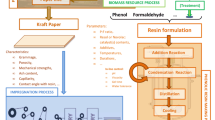Abstract
The article presents research on the use of modified amino-formaldehyde resins in the manufacture of decorative paper laminates.
Similar content being viewed by others
Explore related subjects
Discover the latest articles, news and stories from top researchers in related subjects.Avoid common mistakes on your manuscript.
INTRODUCTION
Modern decorative paper laminates, being a widespread structural finishing material, have a high surface quality, a wide range of colors and patterns, wear resistance and impact resistance, and low sorption capacity. They are resistant to oils, fats, cosmetics, food products, and chemicals; moisture resistant; and resistant to household thermal influences. Decorative laminates are used in the production of furniture for residential and office premises; interior design of hotels, train stations, airports, restaurants, medical, school, sports institutions, vehicles (for example, railway and urban transport cars), and ships; ventilated facades; and floor coatings [1–5].
Currently, for the production of decorative paper laminate, kraft paper is impregnated with phenol-formaldehyde resins, which have a number of disadvantages, such as low reactivity and toxicity due to the release of free phenol and formaldehyde. This work discusses a method for producing decorative paper laminate based on modified amino-formaldehyde resins. The selected impregnating compositions have proven themselves to be effective in impregnating all types of papers used in the manufacture of the product (overlay, decorative paper, underlay, kraft paper).
A method has been developed for the synthesis of impregnating modified amino-formaldehyde resins at a molar ratio of urea to formaldehyde of 1 : 1.8. In the process of testing the synthesis, it was decided to introduce a modifier–catalyst based on salts of polyfunctional acids in an amount of 1% of the volume of the reaction mass.
The formulation of modified amino-formaldehyde resins is presented in Table 1.
The synthesis of modified amino-formaldehyde resins was carried out as follows. Formalin and a modifier–catalyst were loaded into the container for preparing the condensation solution and the stirrer was turned on; then, diethylene glycol, distilled water, and melamine were loaded and the heating was turned on, heating the reactor to 92–95°C. The mixture was kept at this temperature for 30 min. Then, every 5 min, the miscibility with water was checked (a 1-mL sample was taken and injected into 1000 mL of water). After achieving a miscibility of 1 : 1000, the mixture was cooled to a temperature of 85–88°C. Then, urea was added and kept at a temperature of 85–88°C until miscibility with water was 1 : (2.0–3.0). The mixture was cooled to 20–25°C, the pH was adjusted to 9.5–10, and it was poured into a storage container.
Due to the fact that the properties of a freshly prepared oligomer change noticeably during the first day of storage, it is more expedient to carry out the analysis 24 h after the end of synthesis.
The properties of the resulting amino-formaldehyde resins, presented in comparison with the base option (the previously used unmodified melamine resin with a melamine content of 35 wt % was taken as the base option) are presented in Table 2.
Analyzing the data presented in Table 2, we can conclude that the resulting modified resins have a lower content of free formaldehyde, a longer shelf life, and a lower content of expensive melamine.
Based on the developed impregnating amino-formaldehyde resins, decorative paper laminates were obtained. As an impregnation additive, the DL additive was used developed at the Department of the Mytischi Branch of Bauman Moscow State Technical University
Impregnating composition recipe:
MFO-20 resin, kg | 0.5 |
S-30U hardener, kg | 0.0035 |
LD additive, kg | 0.0015 |
Cloud time at 100°C, min | 4.05 |
Impregnation modes: | |
Temperature in the drying chamber, °C | 160 |
Impregnation time, min | 5 |
Figure 1 shows a diagram of the arrangement of layers in the bag before pressing. All layers of paper were impregnated with modified MFO-20 amino-formaldehyde resin.
The resulting paper–resin films had the following characteristics:
• resin content 32–34%;
• volatile content 5–7%.
Based on the resulting paper–resin films, decorative paper laminate was manufactured under the following conditions: pressure 8 MPa, pressing temperature 135–140°C, and pressing time 1 min/mm of plate thickness. The properties of the resulting plastic are presented in Table 3 in comparison with the standard values specified in GOST (State Standard) 9590–76 “Decorative paper laminate plastic. Technical conditions.”
From the data presented in Table 3, we can conclude that decorative laminate plastic obtained on the basis of modified amino-formaldehyde resin fully meets the requirements and allows us to replace the currently used phenol formaldehyde resins with modified amino-formaldehyde resin.
REFERENCES
L. I. Barash, Laminates, Decorative Surfaces (Khimizdat, St. Petersburg, 2007) [in Russian].
M. Yu. Ekimova, V. E. Tsvetkov, and O. P. Machneva, “Aminoformaldehyde oligomers modified with salts of polyfunctional acids,” Klei. Germetiki. Tekhnol., No. 6 (2020).
O. P. Machneva, V. E. Tsvetkov, and M. Yu. Ekimova, “Polyhydric alcohols as modifiers of urea formaldehyde resins,” Klei. Germetiki. Tekhnol., No. 12, 15–18 (2018).
O. P. Machneva, M. Yu. Ekimova, R. I. Viklov, and D. S. Dyuzhakov, “Impregnating resins for the production of laminated particle boards,” in Proceedings of Scientific and Technical Conference, Moscow State Technical University, 2017, pp. 144–146.
V. E. Tsvetkov, M. Yu. Zueva, O. P. Machneva, M. V. Razuvaeva, I. A. Ekimova, N. Yu. Ekomov, V. V. Balyukov, and Kh. A. Fakhretdinov, RU Patent No. 2535226, Byull. Izobret., No. 34 (2013).
Funding
This work was supported by ongoing institutional funding. No additional grants to carry out or direct this particular research were obtained.
Author information
Authors and Affiliations
Corresponding authors
Ethics declarations
The authors of this work declare that they have no conflict of interest.
Additional information
Translated by M. Drozdova
Publisher’s Note.
Pleiades Publishing remains neutral with regard to jurisdictional claims in published maps and institutional affiliations.
Rights and permissions
About this article
Cite this article
Ekimova, M.Y., Tsvetkov, V.E. Modified Amino-Formaldehyde Resins in the Production of Decorative Paper Laminate. Polym. Sci. Ser. D 17, 329–331 (2024). https://doi.org/10.1134/S1995421224700540
Received:
Revised:
Accepted:
Published:
Issue Date:
DOI: https://doi.org/10.1134/S1995421224700540




